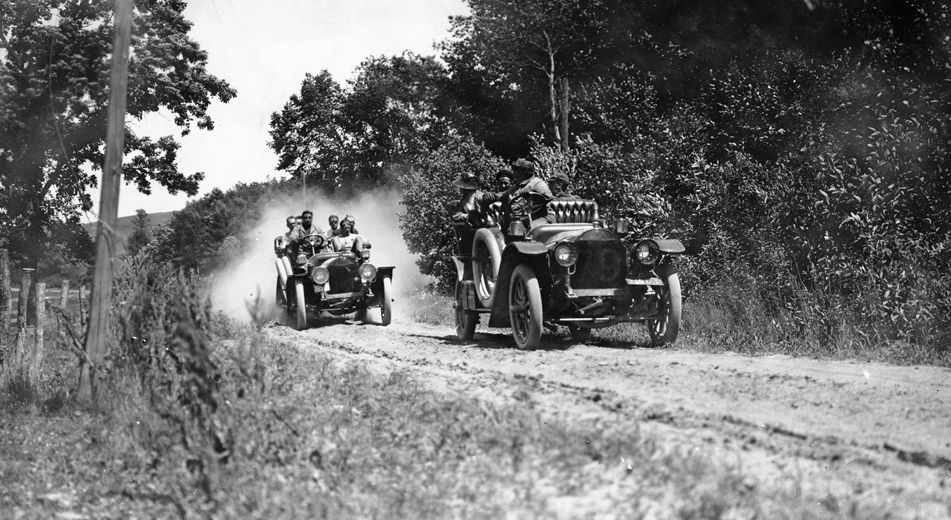Glidden Auto Tour of 1909 Visits Baraboo
by Bill Schuette
The Glidden Auto Tour of 1909 was sponsored by the American Automobile Association and was billed as an Automotive Reliability Tour. It consisted of a cadre of intrepid daring young men of the Edwardian Era, who struck out on an automobile trip which would test the mettle of their endurance, as well as the durability and performance of their vehicles.
During the early part of the last century, automobiles were considered a plaything of the very rich. The tour was established to prove that this mode of travel was a viable form of cross-country transportation for anyone, and to help the country develop safe roads and highways.
Previous auto tours had been staged in the eastern part of the country, such as Pennsylvania and New York. The 1909 excursion was scheduled to tour the Midwest including forays into Wisconsin and a passage through Baraboo. “The Westerners were eager to prove they deserved the honor of hosting despite their suspect roads with a reputation for underdevelopment,” noted a press release.
Boston millionaire, Charles Glidden, put up the first prize consisting of a huge silver trophy. Glidden was a pioneer in the telephone industry and a financier who supported the advancement of the automobile industry in the U.S. He and his wife were the first to circle the globe in an automobile in 1902.
This was not a race, but rather, a test of the reliability of automobile transportation. There were few paved roads during the early 20th century, and even fewer signs or maps to guide travelers. So an adventure like this must have seemed daunting to early horseless carriage pioneers.
The sixth annual Glidden Tour of 2,600 miles began its trek in Detroit on a sunny July morning in 1909. They hoped to end up in Kansas City, by way of Denver, barring any major breakdowns.
Cars were expected to stop at checkpoints along the route to ensure that they were following the rules. Observers in each car recorded all aspects of the tour, including spare parts used, oil consumption, and the time it took to make repairs.
The lead car, known as the “confetti car” scattered confetti on the road as it traveled the route, to mark the trail for those following. There were approximately 31 entrants, with an additional 20 support vehicles.
Several days into the tour, a newspaper reporter filed the following report: “Glancing at their cars you would never believe that just a few days ago they had been brand new. Or had ever been clean. What had once been gleaming paint with intricate Edwardian-era detail and miles of freshly polished chrome was now obscured beneath layers of mud. Tall, smooth fenders had given way to countless dents and dings from rocks and other flying debris. The cars’ thin tires and ornate wooden wheels had started the tour well, but were soon useless on the country roads, taking a toll from the mud and deep wagon ruts. The drivers matched their automobiles in this regard. With their cars’ open air designs they had been exposed to the elements and were caked in dust. Luckily their goggles were still holding up – but they still had another two weeks to go!”
Cites along the way welcomed the cars with celebrations and guided tours of their fair cities. Baraboo, too, hosted the entourage, which rolled through town and up to the square. The Baraboo Daily of July 14, noted that, “The Glidden automobile endurance tour passed through Baraboo this forenoon, and hundreds were out to see the autoists who are contesting for the Glidden…The contestants only slowed down for the corners and crossings, but the press cars stopped and received refreshments, and judging from their dust covered appearance, refreshment of moistening nature would be very acceptable.” The press arrived several hours before the contestants and took breakfast at the Warren House.
The 1909 Glidden Auto Tour will be continued in next month’s article.
Photo Captions:
Studebaker press car photo: The Studebaker press car arrives in Baraboo ahead of the Glidden tour. Photo Courtesy National Automotive History Collection, Detroit Public Library.
Studebakers Photo: Studebakers #79 and #81 on rural road at the 1909 Glidden Tour. Photo Courtesy National Automotive History Collection, Detroit Public Library.


